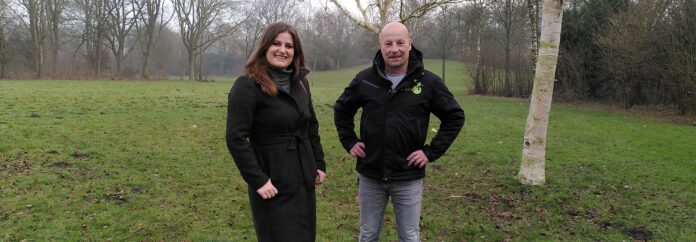
Hugo Jansen and EloÏse van der Laan found they shared a common goal three years ago: to foster biodiversity in their neighbourhood Woenselse Heide. They also found the ideal spot to make a start. One hectare of The Henri Dunant Park near its hub De Splinter will be transformed into a forest garden.
Hugo Jansen, central manager at De Splinter, is a keen nature enthusiast. He approached the municipality a few years ago already with plans to turn part of the park into a forest garden. When he and Eloïse met three years ago, they found they thought along the same lines, and decided to join forces in making it happen.
Three spearheads
EloÏse, who describes herself as a ‘hobby botanist’, found that the peace and relaxation nature afforded during the Covid lockdowns helped her cope. She also realised that food security is not a given when supply lines can become problematic. In addition, the decline in plant and insect diversity worried her. With the help of Suzan Pennings, a connector for Buurt in Bloei (Neighbourhood in Bloom), an initiative of WijEindhoven, things were set in motion. Nature as spearhead one.
Community is key
The municipality supports the project so wholeheartedly to promote community cohesion through this shared goal. And many volunteers are ready to make it a success. Schools play a vital role. Parents collect their children from school, talk to other parents, and so the idea spreads and the pool of volunteers grows. Ideally, says EloÏse, with her roots in childcare and education, the project helps the schools to educate children: it will enliven the class with experiential stories and the urban garden can be used for after school activities.
Three schools in the area are involved: De Ontmoeting, De Tempel, and De Schelp. All three schools have a culturally diverse intake. De Splinter is already a spot where many languages can be heard as families enjoy time out in the open. The joint care for the forest garden will cement this more firmly. Cultural interaction as spearhead two.
Old and young
Not only will schools be involved, but also De Eerdbrand residential care centre, whose residents may enjoy the enrichment to the park, and perhaps share some of their kowledge. The youngest at the nearby Korein Day care centre will also profit from early contacts with nature and the ability to play in a natural environment, as well as growing up with the idea that food does not necessarily come from shops. From young to old and everyone in between: interaction between age groups as spearhead three.
Kick-off
After three years of planning, the project is now ready to start for real: De Splinter will manage the hectare of parkland and keep an eye on it. Early March will see the planting of the first trees. The taller trees will be supplied, planted and maintained by the municipality, which also subsidises the services of a tree expert, Anton Vos, to advise the volunteer group. The planting of the very first trees will be an event with festivities, music, picnic tables, a get-together for the neighbourhood and all those involved in the project.
In the first year, EloÏse says she hopes to have realised the tall trees for fruit and nuts, the planting of shrubs for berries, sowing and planting, and a summer workshop or two. It can continue to expand and consolidate from there. The agricultural school and Scouting Group Livingstone have expressed an interest, volunteer Paulette Kreté offers her marketing expertise and Omines Digital Agency has volunteered help with the online visibility of the project.
Agroforestry
Initiatives to promote biodiversity and local food production are taking root in many communities. For more information on how forest gardens work, watch this video
written by Greta Timmers for EN










